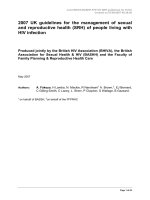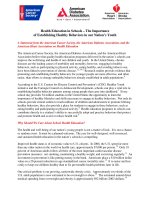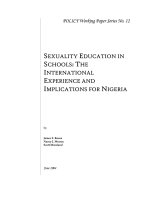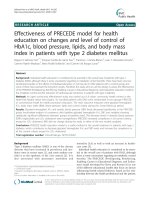Health education in schools - The challenge of teacher training pdf
Bạn đang xem bản rút gọn của tài liệu. Xem và tải ngay bản đầy đủ của tài liệu tại đây (2.43 MB, 146 trang )
Health education
in schools
The challenge of
teacher training
Didier Jourdan
Health education in schools
Health education
in schools
The challenge of teacher training
1
DIDIER JOURDAN
1. In this book, “Teacher Training” refers to all the activities aiming at preparing school staff for a professional role as
a refl ective practitioner. It doesn’t mean training staff to undertake relatively routine tasks. It corresponds to “teacher
education” more and more used in American publications.
Head of collection Thanh Le Luong
Publisher Jean-Marc Piton
National Institute for Prevention and Health Education
42, boulevard de la Libération
93203 Saint-Denis cedex – France
Readers may reproduce this book for their personal or professional
use. Reproduction for resale is prohibited. In case of reproduction,
please quote all sources as mentioned below.
To quote this book : Jourdan D.
Health education in schools. The challenge of teacher training
Saint-Denis : Inpes, coll. Santé en action, 2011 : 144 p.
ISBN 978-2-9161-9231-4
L’auteur
Didier Jourdan, professor at the University Blaise Pascal of Clermont-
Ferrand, France
Avec la collaboration de
Sandrine Broussouloux,Health Promotion and Education Division,
Inpes
Preface
For all individuals, health is a resource that needs to be maintained
and protected. In order to achieve this, all aspects of health must
be considered, as should all the factors that determine it, which
can be biological, psychological, social, economic, cultural and
environmental. In the Ottawa Charter, it was shown that this
holistic view of health, which is akin to “well-being”, was not the
sole responsibility of the health authorities, and that all institu-
tions and regulatory provisions that are involved in how people
live must take their share of responsibility. In their role as places
in which people live, schools play a large role in the well-being
and health of the children and young people within them. Data
from the international scientific literature show the impor-
tance of schools as places where health promotion happens,
not just because an entire cohort attends a school for several
years, but also because there has been shown to be close links
between health and education. Promoting pupil health helps with
educational attainment: increasing levels of education helps
to improve levels of health. In France, the National Institute
for Prevention and Health Education (INPES) is tasked with
developing health education in the environments in which people
live, and with developing training in health education throughout
the country. INPES’ involvement in schools has been formalised in
a partnership agreement with the ministry of education that was
drawn up in 2003, and a 2007 agreement with the French asso-
ciation of deans of faculties of education (IUFM). The expertise
and knowledge within INPES is useful in developing health educa-
tion in schools, in particular via the creation of many documents
and tools that are designed for schools and other educational
establishments. The partnership between INPES and schools
does not just consist of distribution of documents to staff and
pupils: it also involves the creation of a common strategy for the
improvement and promotion of pupil health. A central compo-
nent of this common strategy is training of teachers in health
education. The whole of the educational community has a role to
play in promoting the health of pupils, and teachers, like others,
are called upon to help with promotion of pupils’ health. Studies
suggest that their training will depend in large part on the extent
of their involvement in this area. For this reason, INPES consi-
dered that it was important to address this subject and to sup-
port published work about it. This book has been written by an
expert in the field, Professor Didier Jourdan. The approach he
took involved examining the points of view of the main parties
involved and the mental representations they hold in this area.
This approach also leads to convergence upon a better unders-
tanding by public health professionals of the specific challen-
ges inherent in schools. I hope that it will be a foundation for
fruitful dialogue among all professionals working in school health
promotion internationally.
Thanh Le Luong
Director general of INPES
National Institute for Prevention and Health Education
[Institut national de prévention et d’éducation pour la santé]
Contents
l Preface
13 l Introduction
21 l Teacher training in health education: context
22 l From the school’s point of view, is this a marginal
issue?
22 l Is this a subsidiary issue in the hierarchy of
challenges faced by schools?
24 l Inflation of demands on the education system
25 l Health education: peripheral for teachers, but
nonetheless
27 l Health education in schools
29 l From the point of view of public health: a central
issue
29 l The education system: a key actor in public health
policies
31 l Multiple understandings of health education
35 l Educational systems contribute to health
improvement
35 l A setting that supports health education and
improvements in population health
38 l Schools support student development
40 l Supporting change in educational systems
40 l The role of schools: two understandings
42 l Health education: the specific requirements of a
specific educational context
44 l Accepting the inherent tensions in the school
system
47 l Health education in the school setting
48 l General framework: Creating the conditions
required for educational success and enabling
students to acquire the necessary skills to make
free and responsible health choices
48 l Multiple approaches in the institutional texts
49 l Education as emancipation: the health promotion
perspective
53 l An approach combining protection, prevention and
education
55 l An approach that meets current challenges
58 l Health education: an aspect of citizenship
education
58 l Liberty and responsibility as goals
60 l Health education, school and family
60 l Defining content in reference to social practices
61 l The various themes
64 l Classroom-based activities that are designed to
develop knowledge, skills and attitudes
64 l Background
71 l Knowledge, ability, attitudes
73 l Health education: class-based activities in primary
and secondary schools
79 l Implementing training
80 l Teaching is a skill that can be learned
80 l Class-based and work-based training
82 l Different approaches to training
85 l The purposes of training
85 l Training with professionalism in mind
88 l Training that allows room for reflexivity
94 l Training is not limited to pedagogy
94 l Political function
95 l Technical function
96 l “Pedagogical” function
96 l Support function
98 l Factors conditioning teachers' practices in health
education
99 l Teachers do not just implement the curriculum
99 l Training is not limited to prescription of good
practice
100 l The relative importance of various types of factor
in determining teaching activity
103 l Purposes of teachers’ health education activities
106 l Tools for implementing training programmes
106 l Professional training for adults
125 l Implementing training
133 l Conclusion
137 l List of tables and figures
13
Introduction
If one is truly to succeed in leading
a person to a specific place, one must
first and foremost take care to find
him where he is and begin there.
Anyone who cannot do this is
himself under a delusion if he thinks
he is able to help someone else.
Søren Kierkegaard
1
The Jakarta declaration, like the Bangkok charter, highlighted
several health promotion priorities. Chief among these was the
development of work in specific environments that would be
likely to enable the establishment of overarching strategies.
Schools represent one such environment. The WHO and UNESCO
have produced several recommendations in this area. The
International Union for Health Promotion and Education is also
heavily involved in this movement, particularly with its recent
publication of “guidelines for health promoting schools”.
Many research projects have been conducted in schools. The
results show the importance of health promotion both as a way
of improving health and as a way of helping pupils succeed in
education. However, as the primary task of schools is not to
improve pupils’ health, the development of health promotion is
not an easy matter. It will necessarily involve consideration of
the specific nature of the school environment, and in particular
the way in which teachers perceive their own role in health and
social well-being. The publications show that many factors are
involved in the way in which health promotion schemes are
developed and implemented: a) political will, on which depends
sustainable involvement by institutions and communities;
1. S. Kierkegaard. Translated by Howard V Hong and Edna H Hong.
1414
Health education in schools
b) a favourable environment, in particular in terms of support by
the school’s management team, the existence of teaching prac-
tices that support health promotion, and the importance that is
attached to pupils’ well-being; c) teachers’ own perceptions of
their role in health promotion, their perception of the effective-
ness and acceptability of projects, their feelings of competence
in this area, any burnout and whether they have received trai-
ning in health promotion; d) and factors that are connected to
implementation of the programme itself (training and support
by teams). Training for teachers is often considered as a cen-
tral factor that determines the quality of project implementation.
Studies have shown that teachers who have received training in
health promotion are more likely than those who have received
no such training to be involved in projects, and have a more
holistic approach to health education. Feelings of competence,
and motivation to contribute to health promotion, are also
directly linked to training.
This book is designed for those involved in training teachers
in health education. Its aim is to shed light on the various dimen-
sions of this issue and to explain these using input from several
theoretical frameworks and from our experience in training.
Its primary purpose is to clarify what is at stake. We shall not
be offering a miracle solution, nor shall we be addressing this
issue in the light of just one theory. The reference points we
suggest will provide different ways of thinking about training.
The purpose of this book is to make explicit the various tensions
that are inherent in health education training, and to offer the
reader some tools to deal with them.
It is a book that needs to be set in context. Its content is not
meant to be universally valid. It cannot be directly transposed
into other training contexts which have different target audien-
ces, purposes, and institutional and ethical frameworks. The book
has three parts.
The first is focused on showing the context in which training for
teachers is developed, in the specific area of health education. The
second defines the field of health education in schools, and the
role of teachers. The third contains the theoretical frameworks
that will help in explaining the basis for training modules and the
conditions in which training for teachers in health education can
be properly implemented. The theoretical frameworks that are
proposed will act as ways of interpreting experience. They do not
enable everything to be predicted and controlled, but they do
at least help to explain the basis for actions, give meaning, and
provide hypotheses that can be used in interpretation.
The aims of this book are to explain what is at stake, to offer
starting points for reflection, to show how various parties have
15
Introduction
managed conflicting factors in order to enable stakeholders to
find their own way in their own specific contexts. The hope is that
it will help to support professionals in their work in the service of
education and of public health.
HEALTH EDUCATION: ONE OF THE TASKS
OF SCHOOLS
In France and in most countries, it is not self-evident that
schools, with their public service mission, should be responsible
for health, which is essentially a private, intimate matter. Nor
is there any consensus on how best to approach health issues.
At least two ways of interpreting these issues emerge, if we
examine the arguments that are used in various types of
discourse. The first refers to security, and the second to
promotion of individual and social well-being. The first invokes
the idea of the urgency of prevention (if we do not act now, the
consequences will be terrible in the future, and risk destabilising
our society), and the second invokes broader concerns (promo-
ting social well-being, taking responsibility for one’s own health
and that of the community). The first was the predominant idea
for a long time, but the emergence of both an ethics of individual
well-being and increased expectations that the State will provide
for individuals have led to greater emphasis on the second
idea. These two sources of legitimacy coexist in the educational
system and necessarily involve different ways of perceiving the
role of schools and of teachers.
In this context, with its multiple layers of tension, the educational
system, its partners and the professionals involved in it are all
called upon to contribute to health education. The specific nature
of work in schools arises from the fact that such work is organised
according to our country’s democratic project. As stated in the
first article of the French law on education reform, “In addition
to the transmission of knowledge, the Nation determines that
the primary mission of schools is to have pupils share the values
of the Republic”.
2
The foundation of democracy is confidence
in citizens’ ability to act in a free and responsible way. However,
the capacity to decide for oneself and to take control over one’s
own existence is not innate. Education builds such abilities. In
health, then, the role of schools and others involved in education
(primarily the family) is to support pupils while they learn liberty
and responsibility. In other words, this is about giving citizens
the means to decide for themselves, and not allow the media,
commercial companies, gurus or experts to do this form them.
2. Law no. 2005-380 dated 23 April 2005 concerning school reform.
1616
Health education in schools
The main consequence of considering health as part of this
project that underlies all school activity is the fact that health
should not be considered as an end in itself and the ultimate
aim of existence. In a democratic society, health cannot be a
substitute for universal emancipation. It is a precondition for
being able fully to enjoy citizenship, and not an aim in itself.
It should be said clearly that we consider that it is unrealistic
to try to make progress on the issue of training for teachers in
health education, while acting as though everything were clearly
defined and that the only obstacles were ignorance (they didn’t
know his was a serious issue, and they only need telling in order
to be convinced), willingness on the part of those involved (if they
do not do this, it’s because they resist it for the wrong reasons,
we should understand the nature of the various constraints in
order to be able to overcome them) and lack of time (it is true
that there are other priorities, but action should be taken to put
health higher on the list). The first step in a training plan is to set
out clearly what is at stake. This is what we shall attempt to do,
succinctly, in this book.
HEALTH EDUCATION IN TEACHER TRAINING
The specifications for teacher training
3
grant a significant place
to health issues. They state that training for primary teachers
(para 1.2) must use a common national framework, based on
“official texts that state the non-subject educational commit-
ments of the school, in particular health education and education
in environmental issues and sustainable development…” Health
and prevention are issues that call upon the professional compe-
tencies of teachers (para 3), both as subjects to be taught along
with all non-subject areas of education, and as components of
the civil servant’s role (acting in an ethical and responsible way)
“to identify students who have difficulties with health issues
and high-risk behaviour” and “to take responsibility for students
who have disabilities”. Finally, the issue of partnerships, which
is central to health education, is brought to the fore: working
as a team and together with parents and partners (in particular,
medical and social work professionals, public services etc.). More
generally, this stresses the non-subject educational dimension
of teachers’ professional practice and emphasises the need for
professional practice to take into account the school’s collective
programme, and for there to be communication with students
and parents. This will not lead to the creation of a new area of
training. Such a step would only contribute to the fragmentation
3. Circular dated 4 January 2007 relating to specifications for teacher training.
1717
Introduction
4. Legarder A., Simmoneaux L. (2006). L’école à l’épreuve de l’actualité [Schools: the chal-
lenge of current issues]. Enseigner des questions vives [Teaching live issues]. Paris, ESF.
of teacher training. Training in health education can be a way of
bringing the disparate parts of training together, rather than just
adding yet more content. All teachers are faced with the issues of
high-risk behaviour, and ask themselves about the role of schools
in this area (should they contribute to persecution of smokers, or
to stigmatising fat people? should they contribute to the “ideal
body” movement, as our individualistic societies tend to pro-
mote? or should they abandon all conversation about sexuality,
violence and drugs?) and about their own individual roles (how
can and must I contribute to pupils’ education in these areas,
which, although they are fundamental, lie between the public and
private spheres? What should I say to a pupil who has used can-
nabis and who seems not to be doing well? How should I act with
regard to alienation that is caused by stereotypes about body
shape, alcohol and sexuality?). Daily life in schools is such that
the primary challenge is always crisis management, but the issue
of prevention and education in these areas rapidly arises. Dealing
with such “live issues”
4
of citizenship with students and those
in school-based training is a way of encouraging them to bring
together their various areas of knowledge, both academic (scien-
tific, historical, legal, ethical) and drawn from their experience,
which will help them to find their place as teachers. Health edu-
cation is one of the elements of the common culture shared by
all teachers, whether primary or secondary.
CONSIDERING THE VARIOUS DIMENSIONS
OF TRAINING
In the health education field, as in all other fields, teachers’ activi-
ties do not simply consist of implementing government circulars
or programmes. The factors that determine this type of education
are much more complex. Activities depend on factors that can
be institutional (requirements of programmes, the school’s goals,
circulars) but also personal (teachers’ own representations of
their task in health education, personal narratives) or connected
to the intended audience (students and their needs and expec-
tations). Training needs to allow for these three complementary
aspects. This does not mean that each module and training
session must incorporate all three aspects, but care must be
taken to ensure that they are included overall. Implementation
of training cannot, therefore, be limited to merely recommending
good practice. The issue is to understand the inherent contra-
dictions of the teaching profession, between students’ learning
18
needs and the demands of doing the job, if a truly appropriate
type of training can be offered
5
. Teachers, like all professionals,
are not robots performing a prescribed series of actions, but are
subject to a set of constraints on their actions, and from these
constraints emerges a way of performing professional activities.
From nursery schools to high schools, “teachers make multiple
decisions for which there are many reasons other than promo-
ting students’ learning: for example, in order to remain in the stu-
dents’ favour, in order that students are not “set up to fail”, in
order to maintain a good atmosphere in class, in order to keep up
their own motivation levels, or in order to conserve their energy.
All teachers have to feel good enough in class in order to “get
through” each day and “last” throughout a career”
6
.
Because health education is a marginal area of teaching
activity, the various factors that determine it should be taken
into account, and work should be done to bring health education
together with the other dimensions of the teaching profession.
Such education is not at the heart of teachers’ professional
identity, and it is not useful to act as though it were. The vast
majority of teachers are aware of their role in this area, but the
huge number of prescribed activities in all areas means that
health education appears to be just one more activity, a further
burden to be added to the already heavy load. In order to make
progress, we must take care to find the teachers where they are
and begin from there.
Training for teachers in health education cannot therefore be
limited to organising information sessions on various health-
related themes. Progress can only be made on this issue if it is
carefully integrated with the other aspects of the modern tea-
ching profession, and if it is placed at the heart of any plan to
redefine teaching. We are taking the chance that it is possible
to navigate a path between these various obstacles in order to
carry out schools’ mission to emancipate individuals, with refe-
rence to what they are called upon to transmit: “that which uni-
tes and that which frees
7
”.
5. Goigoux R. (2007) “Un modèle d’analyse de l’activité des enseignants” [A model for
analysing teaching activity]. Éducation et didactique n°3 [Education and Didactics, issue 3].
6. Goigoux (2007) Ibid.
7. Reboul O. (2001) La philosophie de l’éducation - 9e éd [The Philosophy of Education, 9th
edition]. - Paris: PUF - coll. Que sais-je ? n°2441 [number 2441 in the “What do I know?”
collection]. By “that which unites”, Reboul is referring to the elements that will enable an
individual to integrate socially into as broad a community as possible, and by “that which
frees” he means that which will enable all individuals to be able to express themselves and
think for themselves.
Health education in schools
1. Jourdan D., Samdal O., Diagne F. and Carvalho G.S. (2008) The Future of Health Promotion in Schools goes
through the strengthening of Teacher Training at a global level Promot Educ. 2008 Sep;15(3):36-8.
2. Perrenoud P. (1994) La formation des enseignants entre théorie et pratique [Teacher training: between theory and
practice], Paris, L’Harmattan.
The aim of this first section is to make explicit the way in which the issue of the trai-
ning of teachers in health education is approached. As there are several ways in
which the context can be analysed, it should be specified here which analysis was
used when writing this book. Our attention is drawn to the point of view of educa-
tion and schools.
In any case, it is necessary to take into account the set of constraints that currently
apply to teacher training
1
. A middle way should be found, between wide-eyed uto-
pianism and conservative realism
2
. It would be of little use to draw up a training
programme that is too far ahead of developments of the profession in schools, as
though health education were a daily preoccupation of all those involved in school
life. It would be of equally little use to adhere too closely to the current situation,
limiting training in health education to physical education or biology teachers who
transmit health knowledge in close relationship to their subject. Teachers who are
currently in the early stages of training must be able to negotiate and master the
likely changes to their profession that they will encounter throughout their careers,
between 2009 and (at the earliest) 2049. It is necessary to consider the profession
now and in the future, and to attempt to identify sources of support for teachers
when they seek to contribute to their students’ educational success and health.
Teacher training in health education:
context
2222
From the school’s
point of view, is this
a marginal issue?
IS THIS A SUBSIDIARY ISSUE IN THE HIERARCHY
OF CHALLENGES FACED BY SCHOOLS?
Schools face multiple types of demand every day. They are places where
society’s main concerns all converge. How then can health education find a
place within the multiple roles of the education system? It is straightforward
to show that the issue of health education has links with the main issues that
are currently examined in schools, and that it is one of the ways in which the
huge changes in our education system are being expressed
[1]. Health edu-
cation, if it is not conceived of as the transmission of intangible rules, can
be an excellent way of drawing out and making explicit the tensions between
potentially conflicting areas of teaching activity, and of exploring ways in
which these tensions may be reduced.
Health education is a constituent part of any humanities education programme.
All civilisations pass down prescriptive advice about health
1
as part of collective
wisdom, and since its foundation the French education system, as well as all
school systems, has positioned itself as a participant in public health
[2]. The
idea that positive health behaviours can be acquired in childhood has led the
political authorities to assign schools the task of prevention. From the lessons
about hygiene, tuberculosis and alcoholism that were common at the end of
the last century to the point at which health education was included in the
1. This issue is eminently political, as Disraeli, who was Prime Minister under Queen Victoria, said: “The health of the
people is really the foundation upon which all their happiness and all their powers as a state depend.”
23
From the school’s point of view, is this a marginal issue?
French common base of knowledge and skills
2
, schools have always been one
of the main places in which health prevention and education take place
[box 1].
Despite all this, this health-related education has taken different forms at
different times, and must be re-assessed constantly.
BOX 1
Extract from book
“
Health lessons - Secondary schools (girls)
- third year
”
, published by Nathan in 1920. In this text, schools
and teachers are instruments of public health
1
. “Hygiene must
be inculcated in primary school as well as in secondary school;
if taught in schools and espoused by schools, it will truly
become normal practice”.
In France, not until 1902 did we pass legislation concerning the protection of public health and
the organisation of health services, and it would be premature to state that this is currently fully
functional. In major centres, hygiene offi ces have been created in order to watch over public
cleanliness; however, in small towns and rural areas, nothing has yet been done. In almost every
area, public opinion remains unenlightened, and only when the public becomes supportive of the
administrative prescriptions will these prescriptions cease to be mere words on a page and will
the principles of hygiene start to become normal practice!
Hygiene rules are at times troublesome for the general public, as they carry an obligation to break
with everyday habits; it is therefore necessary that these be properly understood, so that they
may be accepted and not merely endured.
As Professor Vidal says, it is not enough simply to promulgate a hygiene law; it has to be applied.
Effective implementation of such a law requires individual effort from each citizen; we must start,
therefore, by ensuring that this law is understood. Only by introducing young people to the basic
principles of hygiene, which should be among the fi rst rules taught to children, will we achieve
this result. Hygiene must be inculcated in primary school as well as in secondary school; if taught
in schools and espoused by schools, it will truly become normal practice.
1. This idea can be found in current texts, for example the Flageolet report on this issue (Mission au
profi t du gouvernement relative aux disparités territoriales des politiques de prévention sanitaire avril 2008
[Government-commissioned report on regional disparities in health prevention policies, April 2008]): “Schools
are therefore the primary public and collective vector of health. Age-appropriate health knowledge must be
transmitted, by school teachers in particular. It is essential to convey messages about health protection
which will, in turn, enable messages about risk (sexually transmitted infections, contraception, addictions)
that are conveyed from collège level (age 11-15) onwards to be placed in context.” p. 52, and “However, in
order to provide a culture of health for everyone and to ensure that everyone is aware that it is possible to
manage one’s own health, many vectors must be used and the same coherent message must be repeated
constantly. Regardless of their age, people must be enabled to integrate advances in the health fi eld into their
way of thinking. For this reason, it is necessary to call on the things that people hold most dear in order to
convey the message repeatedly and have the best chance of reaching people. The advertising industry has
understood this well, as shown by the use of children to sell the products the industry promotes.” p. 53
2. />24
Health education in schools
INFLATION OF DEMANDS ON THE EDUCATION SYSTEM
What does it mean to be a teacher? It is an understatement to say that the
identity of the teaching profession is in crisis
3
. It is no longer just about
transmission. As Philippe Meirieu states
[3], “schools are torn between multiple
contradictory functions: teaching mastery of traditional languages and introducing
new technologies; transmitting traditional knowledge and enabling understanding
of contemporary situations; allowing for differences and ensuring a common
educational base; helping students to succeed in examinations and teaching how to
live in society; providing training in environmental awareness and in road safety;
providing health education, preventing AIDS, informing of the dangers of drug
addiction, and many other things besides”. The demands on the school system
have indeed grown. It is not reasonable to consider health education in schools
as just another demand to be added. The main issue we face is that of coherence
etween the various aspects of teaching, as part of an updated definition of what
it means to be a teacher
[4]. Promoting health
4
in schools primarily means
that those involved should work in an institutional context that enables them
fully to carry out their educational task.
Firstly, it is necessary to consider the role of these questions within school
life and within the teaching profession. It is also important to ask questions
about the way in which training can help teachers to build a professional
identity that will enable them to meet current and future challenges. This
clearly means that the current situation does not entail that we should
demand a few hours for a training module; rather, it should be emphasised
that together with other types of education (e.g. sustainable development,
environment, law, media, economics, consumer education), the heart of the
teaching profession should be a citizenship education that is appropriate to
current and future challenges.
The role of health education in the school system must therefore not be consi-
dered in terms of a body of knowledge, but as a way of re-assessing the teaching
profession and strengthening the core of the school system: an education in
“how to be a citizen”. In other words, the aim is to ensure that health educa-
3. The fact that the teaching profession is currently in crisis does not mean that this situation is exceptional. In fact,
all the signs point to this problem being permanent. Even in 1899, in his “Enquête sur l’enseignement secondaire,
rapport général à la chambre des députés” [Inquiry into secondary education; general report to the Chambre
des Députés], H. Ribot wrote: “We have sought with the greatest sincerity the causes of the malaise in secondary
education”. Similarly, in the introduction, the 1972 report by L. Joxe entitled “La fonction enseignante dans le second
degré, Rapport au ministre de l’Éducation nationale” [Secondary teaching: Report to the Ministry of Education]
contained the following: “It will not be possible to approach the problems caused by the malaise among teachers,
and more generally by the crisis in teaching, without first establishing the quantitative elements of these problems”.
These two quotations are drawn from the “Livre vert sur l’évolution du métier d’enseignant” [Green Book on
changes in the teaching profession] which was created under the leadership of Marcel Pochard and given to the Prime
Minister on 4 February 2008, and which contained an attempt to answer the questions that are being asked here, and
suggestions for political action that could be taken to answer those questions. We can certainly hypothesise that the
position of schools at the heard of social tension and in the midst of a perpetual discrepancy between “what is” and
“what should be” leads to ongoing readjustment which has an effect on staff.
4. Health promotion is the process of enabling people to increase control over, and to improve their health. This
arises from a concept of “health” defined as “a state of complete physical, mental and social well-being, an individual
or group must be able to identify and to realize aspirations, to satisfy needs, and to change or cope with the environ-
ment”. This will be more precisely defined in chapter 2.









